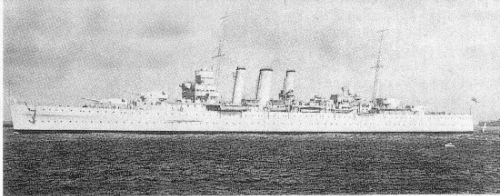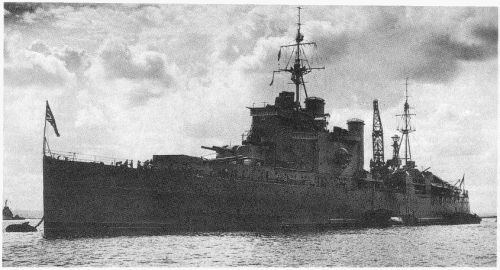
NAVYPEDIA
 Support the project with paypal
Support the project with paypal
Photo

Sussex 1929
Ships
| Name | No | Yard No | Builder | Laid down | Launched | Comp | Fate |
|---|---|---|---|---|---|---|---|
| Devonshire | 39, 1948- C39 | Devonport DYd | 16.3.1926 | 22.10.1927 | 18.3.1929 | TS 1947, sold for BU 6.1954 | |
| London | 69, 1948- C69 | Portsmouth DYd | 23.2.1926 | 14.9.1927 | 31.1.1929 | sold for BU 1.1950 | |
| Shropshire (RAN 25.6.1943) | 83, 1948- C83 | 647 | Beardmore, Dalmuir | 24.2.1927 | 5.7.1928 | 12.9.1929 | sold for BU 7.1954 |
| Sussex | 96, 1948- C96 | 544 | Hawthorn Leslie, Hebburn | 1.2.1927 | 22.2.1928 | 19.3.1929 | sold for BU 1.1950 |
Technical data
| Max speed, kts, kn | 32.3 |
|---|---|
| Displacement standard, t | 9830 - 9850 (10575 - 11015 finally) |
| Displacement full, t | 13315 (14280 - 14580 finally) |
| Length, m | 181.4 pp 192.0 - 192.9 oa |
| Breadth, m | 20.1 |
| Draught, m | 6.32 deep load (6.78 - 6.91 finally) |
| No of shafts | 4 |
| Machinery | 4 sets Parsons geared steam turbines, 8 Admiralty 3-drum boilers |
| Power, h. p. | 80000 |
| Fuel, t | oil 3210 (later 3000 - 3043) |
| Endurance, nm(kts) | 12500(12) |
| Armour, mm | box protection to magazines: 102 - 25, belt: 25, barbettes: 25, turrets: 25, deck: 38 - 25 |
| Armament | 4 x 2 - 203/50 BL Mk VIII, 4 x 1 - 102/45 QF Mk V, 4 x 1 - 47/40 Hotchkiss Mk I, 4 x 1 - 40/39 2pdr QF Mk II, 2 x 4 - 533 TT |
| Complement | 700 |
Standard scale images

London 1942

Devonshire 1944
Graphics
Project history
Ships of the class were designed under 1925 Programme and repeated Kent class but had more traditional hull form (without bulges) and a fwd superstructure moved aft by 7.5 m for improvement of horizontal aiming arcs of "B" turret.
London in 1939-1941 passed the major modernization. She received narrow armored belt abreast machinery. Fwd superstructure was completely rebuilt, becoming similar on standing on King George V class battleships. Boiler uptakes were deduced into 2 funnels. The longitudinal catapult and large hangar are fitted.
Protection
Magazines were protected by 111 (102mm armour on 9mm plating) - 25mm sides and 76 - 25mm platform deck. Machinery was protected by 25mm bulkheads and 32mm deck. Steering gear had 38 - 25mm horizontal protection.
Modernizations
1931 - 1932, all: + 1 catapult E-II-H, 1 Fairey IIIF seaplane (replaced by Osprey 1934 and Walrus 1937)
1934, Shropshire: + 1 x 4 - 40/39 2pdr QF Mk VIII
1935, Shropshire: - 1 x 4 - 40/39
1936 - 1937, Devonshire, Shropshire, Sussex: - 4 x 1 - 40/39; + 4 x 1 - 102/45 QF Mk V, 2 x 4 - 12.7/62
1937, London: - 4 x 1 - 40/39; + 4 x 1 - 102/45 QF Mk V
1939, all: - 4 x 1 - 47/40
mid-1940, Sussex: + 2 x 20 - 178 UP AA rockets projectors
(Chatham DYd, 3.1939 - 4.1941), London: New 89mm belt 2.4m in height protected machinery spaces. Superstructures were reconstructed, ship had from now only two funnels. - 8 x 1 - 102/45, catapult E-II-H; + 4 x 2 - 102/45 QF Mk XVI, 2 x 8 - 40/39 2pdr QF Mk VIII, 2 x 4 - 12.7/62, 1 catapult D-I-H with 2 Walrus seaplanes, type 279, type 284, type 285 radars. Displacement rose to 11015/14578t.
5/1941, Devonshire: + 2 x 8 - 40/39 2pdr QF Mk VIII, type 281, type 285 radars
6/1941, Shropshire: + 2 x 8 - 40/39 2pdr QF Mk VIII
9/1941, Devonshire: + 2 x 1 - 20/70 Oerlikon Mk II/IV
1/1942, London: - 4 x 4 - 12.7/62; + 8 x 1 - 20/70 Oerlikon Mk II/IV
2/1942, Devonshire: + 6 x 1 - 20/70 Oerlikon Mk II/IV, type 273 radar
2/1942, Shropshire: - 8 x 1 - 102/45; + 4 x 2 - 102/45 QF Mk XVI, 7 x 1 - 20/70 Oerlikon Mk II/IV, type 273, type 281, type 282, type 285 radars
8/1942, Sussex: - 8 x 1 - 102/45, 2 x 4 - 12.7/62, 2 x 20 - 178 UP; + 4 x 2 - 102/45 QF Mk XVI, 2 x 8 - 40/39 2pdr QF Mk VIII, 10 x 1 - 20/70 Oerlikon Mk II/IV, type 273, type 281, type 282, type 285 radars
late 1942, Devonshire: - 8 x 1 - 102/45; + 4 x 2 - 102/45 QF Mk XVI
late 1942, Shropshire: + 3 x 1 - 20/70 Oerlikon Mk II/IV
5/1943, London: - catapult with seaplanes; + 7 x 1 - 20/70 Oerlikon Mk II/IV, type 273, type 282 radars
mid-1943, Devonshire: - 6 x 1 - 20/70, 2 x 4 - 12.7/62, type 281 radar; + 2 x 8 - 40/39 2pdr QF Mk VIII, 12 x 2 - 20/70 Oerlikon Mk II/IV, type 281B radar
6/1943, Shropshire: - 4 x 1 - 20/70, 2 x 4 - 12.7/62, catapult with seaplanes; + 7 x 2 - 20/70 Oerlikon Mk II/IV
12/1943, Sussex: - catapult and seaplanes; + 11 x 1 - 20/70 Oerlikon Mk II/IV
2/1944, London: - 3 x 1 - 20/70; + 4 x 2 - 20/70 Oerlikon Mk II/IV
3/1944, Devonshire: - 1 x 2 - 203/50 ("X"), 1 x 2 - 20/70, catapult with seaplanes; + 2 x 8 - 40/39 2pdr QF Mk VIII, 8 x 1 - 20/70 Oerlikon Mk II/IV, type 282, type 283 radars
3/1945, Sussex: - 1 x 2 - 203/50 ("X"), 15 x 1 - 20/70, type 281 radar; + 4 x 8 - 40/39 2pdr QF Mk VIII, 4 x 2 - 20/70 Oerlikon Mk II/IV, type 281B, type 283, type 293 radars
6/1945, London: - 8 x 1 - 20/70, type 273 radar; + 4 x 1 - 40/56 Bofors Mk I/III, 4 x 2 - 20/70 Oerlikon Mk II/IV, type 277, type 283 radars
mid-1945, Shropshire: - 7 x 2 - 20/70, 6 x 1 - 20/70, type 273 radar; + 7 x 1 - 40/56 Bofors Mk I/III, type 277, type 293 radars
late 1945, London: - 8 x 2 - 20/70, 4 x 1 -20/70
1.1946, Devonshire: 3 x 2 - 203/50 Mk I, 4 x 2 - 102/45 Mk XIX, 6 x 8 - 40/39 Mk VIA, 11 x 2 - 20/70 Mk V, 10 x 1 - 20/70 Mk III, 2 x 4 - 533 TT, type 273, type 281B, type 282, type 283, type 285 radars
1.1946, London: 4 x 2 - 203/50 Mk I, 4 x 2 - 102/45 Mk XIX, 4 x 1 - 40/60 Mk III, 2 x 8 - 40/39 Mk VIA, 8 x 1 - 20/70 Mk III, 2 x 4 - 533 TT, type 277, type 279, type 282, type 283, type 284, type 285 radars
1.1946, Sussex: 3 x 2 - 203/50 Mk I, 4 x 2 - 102/45 Mk XIX, 6 x 8 - 40/39 Mk VIA, 4 x 2 - 20/70 Mk V, 6 x 1 - 20/70 Mk III, 2 x 4 - 533 TT, type 273, type 281B, type 282, type 283, type 285, type 293 radars
4/1947, Devonshire as TS: New armament consisted of 1 x 2 - 203/50 Mk I ("B" position), 2 x 2 - 102/45 Mk XIX, 4 x 1 - 47/40 Mk I, 1 x 4 - 40/39 Mk VII, 1 x 1 - 40/60 Mk III, 3 x 1 - 20/70 Mk III. Only 4 boilers were operable, maximal speed felt to 21kts. New classification was "Oceangoing training cruiser".
Naval service
Sussex was sunk 18.9.1940 in dock of Clyde after 250kg bomb hit; she was salvaged and repaired for 21 month (recommissioned in June 1942). Devonshire served as TS 1947 - 1953.
Many thanks to Wolfgang Stöhr for additional information on this page.
 HOME
HOME FIGHTING SHIPS OF THE WORLD
FIGHTING SHIPS OF THE WORLD UNITED KINGDOM
UNITED KINGDOM CRUISERS
CRUISERS LONDON heavy cruisers (4, 1929)
LONDON heavy cruisers (4, 1929)

